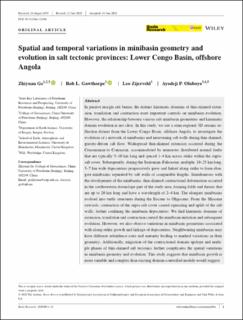| dc.description.abstract | In passive margin salt basins, the distinct kinematic domains of thin‐skinned extension, translation and contraction exert important controls on minibasin evolution. However, the relationship between various salt minibasin geometries and kinematic domain evolution is not clear. In this study, we use a semi‐regional 3D seismic reflection dataset from the Lower Congo Basin, offshore Angola, to investigate the evolution of a network of minibasins and intervening salt walls during thin‐skinned, gravity‐driven salt flow. Widespread thin‐skinned extension occurred during the Cenomanian to Coniacian, accommodated by numerous distributed normal faults that are typically 5–10 km long and spaced 1–4 km across strike within the supra‐salt cover. Subsequently, during the Santonian–Paleocene, multiple, 10–25 km long, 5–7 km wide depocentres progressively grew and linked along strike to form elongate minibasins separated by salt walls of comparable lengths. Simultaneous with the development of the minibasins, thin‐skinned contractional deformation occurred in the southwestern downslope part of the study area, forming folds and thrusts that are up to 20 km long and have a wavelength of 2–4 km. The elongate minibasins evolved into turtle structures during the Eocene to Oligocene. From the Miocene onwards, contraction of the supra‐salt cover caused squeezing and uplift of the salt walls, further confining the minibasin depocentres. We find kinematic domains of extension, translation and contraction control the minibasin initiation and subsequent evolution. However, we also observe variations in minibasin geometries associated with along‐strike growth and linkage of depocentres. Neighbouring minibasins may have different subsidence rates and maturity leading to marked variations in their geometry. Additionally, migration of the contractional domain upslope and multiple phases of thin‐skinned salt tectonics further complicates the spatial variations in minibasin geometry and evolution. This study suggests that minibasin growth is more variable and complex than existing domain‐controlled models would suggest. | en_US |

